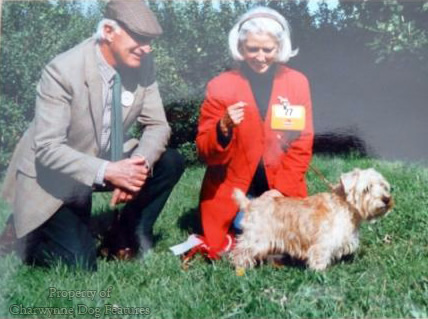265 Lucas Terrier Critique
LUCAS TERRIER ANNUAL SHOW 1997: JUDGE'S CRITIQUE
by David Hancock
General Comments. It was a genuine pleasure to judge a show where the atmosphere was friendly but competitive, the affection for the dogs obvious and the dedication to the breed so measurable yet still open-minded in approach. The emerging breed still has some way to go with regard to the fixing of breed-type, especially in coat texture, head structure and the desired ratio of height to length. I believe the breed standard should set out some guidance on the latter point. My own strongly-held view is that every breed of sporting terrier should have the spirit and the anatomy which allows it to work, even if not required to do so. Sadly, many terriers in KC-approved show rings look good but have dreadful movement, arising from faulty construction. At this show I looked hard for overall physical soundness; fault-judging removes far too many good dogs from breeding programmes. It is easier to breed out a particular flaw in an otherwise sound dog than to try to breed in good points to a physically unsound dog. Soundness and type should be the two main aims in future breeding plans, in my view, after seeing the exhibits at this show.

Size. Working terriers seem to do best when their height/weight ratio is appropriate, i.e. a 14lb dog is 14" at the withers. There are of course Dandie Dinmont terriers in the show ring weighing 20lbs from a shoulder height of 10", but they are no longer sporting terriers. I cannot see the advantage of the seeking of heavy bone in a terrier; nature will provide strong flat bone if the dog is "bred right and fed right". The cloddy show Sealyham terrier is a classic case of the unwise pursuit of heavy bone and a boot-box head. A disproportionately large head does not give a dog a stronger jaw; the Staffordshire bull terrier demonstrates how jaw strength comes from construction rather than size. A balanced dog, without exaggeration, is always a better dog.
Heads. There was a wide variation in heads at the show. Some dogs had skulls which were too small and there was a general lack of width between the ears. The breed standard should give guidance on the stop; I believe it should be well-defined. Mouths were surprisingly good, given the variation in heads, but there were many dirty teeth. A scissors bite, rightly, is desired but as my placings indicated on the day, every fault should be judged not only in degree but also in relation to the whole dog. I would question the wisdom of not breeding from an otherwise good dog featuring an undershot jaw. If the breed gene pool is able to offer better dogs with scissor bites, I can well understand the unwillingness to breed from a dog with a faulty mouth; but the Lucas Terrier Club is not in that position. Eyes and ears were generally sound, pigmentation was good and expressions largely terrierlike.
Neck. This is not mentioned in the breed standard but is a vital component in a successful sporting terrier. I looked for good length, strong muscles, a slight arch widening into well-laid shoulders. Far too many exhibits had thin necks.
Forequarters. I was disappointed to find upright shoulders and a distinct lack of length in the upper arm. These are bad faults and handicap a functional terrier to an unacceptable degree.
Body. A proportionately broad chest is required by the standard but was not a uniform feature amongst the entry. I would prefer to see the standard demand well-rounded ribs, flattening to a deep chest, carried well back. Too compact a dog, with too short a back, leads to a lack of flexibility when working underground. Too many exhibits lacked lungroom.
Hindquarters. This is not well covered in the breed standard. I found weak muscles, limited drive and a lack of substance in bone structure in a disappointingly high number of exhibits. I looked for a low set hock with strong propulsion, a well-turned stifle and hard thigh muscles.
Miscellaneous Comments. There were too many soft-coated dogs, too many long-coupled dogs and more than a few lacking that essential self-confident, outgoing, 'have a go' philosophy of the true terrier. The club will have to make a positive decision soon as to whether the show Sealyham terrier is a suitable type-model for the emerging breed. Most of the former that I see in the show rings are not worth emulating, despite their flashy appearance. Finally, it was heart-warming to see this attractive breed being favoured -- and by such charming people. May the breed, and its fanciers, go from strength to strength, and, above all, retain the friendly club atmosphere, especially when rosettes are on offer.